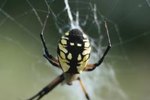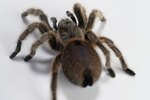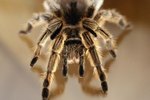
The disparate regions of Nepal -- a small southeast Asian country that has mountains, savannas, grasslands and part of Mount Everest within its borders -- allow a wide variety of flora and fauna to thrive. Four spider species are reported to be unique to the southeast Asian region, including Nepal. They are species of colony spiders, tarantulas, goblin spiders and jumping spiders.
Stegodyphus Sarasinorum
Stegodyphus sarasinorum is a colony spider, meaning that it lives in a large saclike web along with many others of its species, and cooperates in the building, maintenance, and repair of that web -- kind of like an ant in an anthill or a bee in a beehive. The web is made of a particularly sticky silk produced by the spiders, and any smaller insects that become trapped in it are unable to free themselves. This spider primarily resides and builds webs in thorny bushes found in Nepal and other Southeast Asian countries.
Haplocosmia Nepalensis
Although tarantulas can be found in many countries and habitats around the world, Haplocosmia nepalensis are native to Nepal. Their bodies consist of two distinct parts -- the carapace, or front portion including the eyes and a protective plate, and the abdomen. Like all tarantulas, they are distinctively hairy and use fine hairs on their legs to detect air movement, thereby sensing when predators or prey are nearby. These tarantulas do not build a web; rather, they prefer to live alone in a self-constructed burrow.
Brignolia Ankhu
More commonly known as a goblin spider, Brignolia ankhu is just one of hundreds of goblin spider species found around the world. He is a particularly small spider, usually growing to only about 2 millimeters, or 0.08 inch, and gets his name from his secretive nature and his proclivity for hiding under leaves that litter the ground. The spider has been relatively unknown until recently because his size makes him easy to miss, but scientists have identified more than 1,000 goblin spider species.
Euophrys Omnisuperstes
The words “Himalayan jumping spider, the common name for Euophrys omnisuperstes, might spark a few nightmares, but luckily the spider is found only high in mountainous regions. It has been discovered as high as 6,700 feet above sea level on Mount Everest. Fittingly, the creature's scientific name means “standing above everything.” The creature does not spend much time in the open, instead preferring to lurk in the dark crevices of rocks. His diet consists of smaller insects that are blown up the sides of mountains.
References
Photo Credits
-
John Foxx/Stockbyte/Getty Images
Writer Bio
Juliana Weiss-Roessler has been writing since 2000. She worked as the head of the Web content department for the star of an Emmy-nominated reality series. Her ghostwriting has appeared in "PARADE" and "People." Weiss-Roessler is a blogger for Resumark and an editor for Pink Raygun. She has a Bachelor of Arts in English from the University of Florida.




